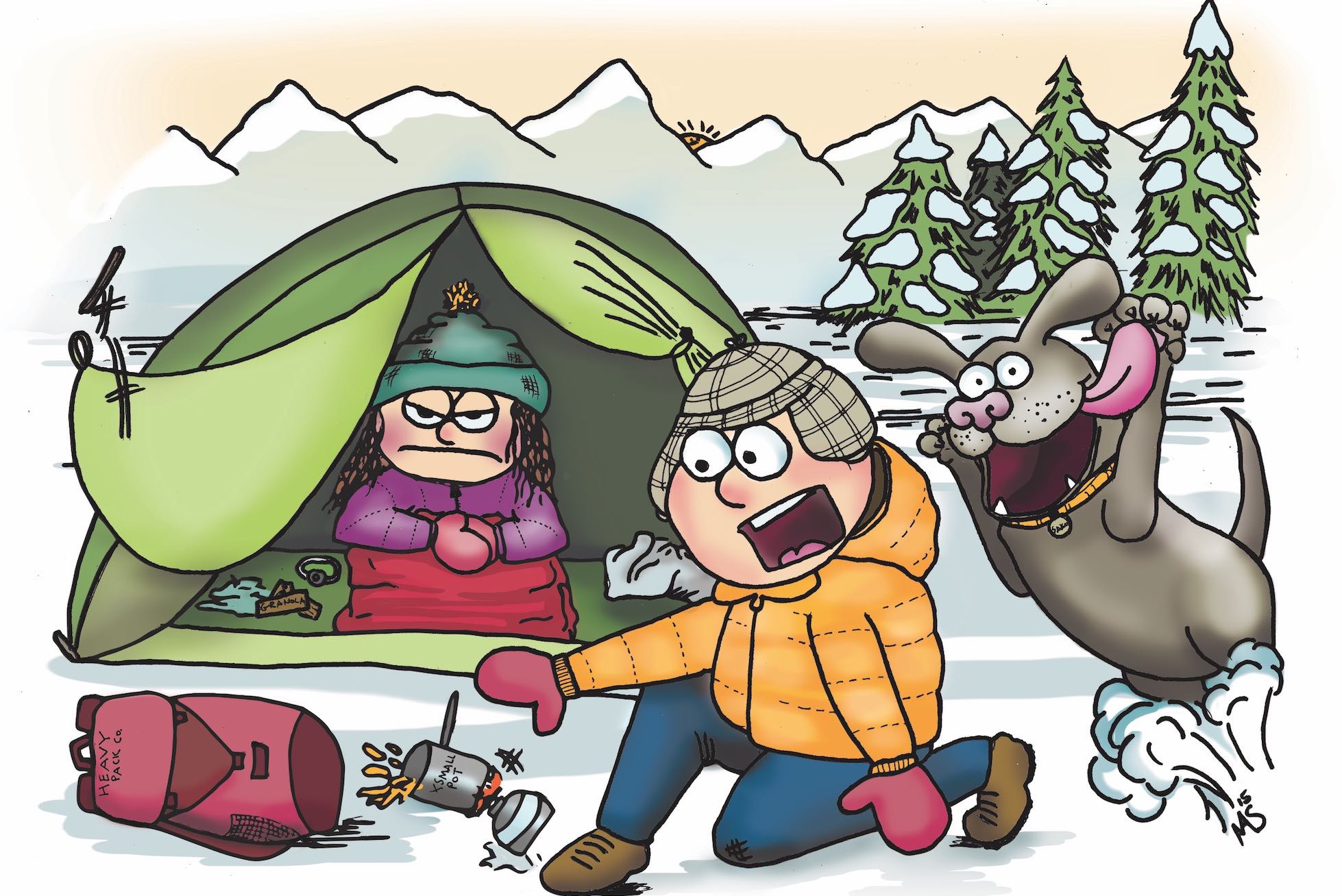By Maggie Slepian EBS CONTRIBUTOR
There are plenty of sensible winter activities in Montana. Most folks ski, snowboard, ice climb or borrow a kid and go sledding. I’m in the minority of Montana-dwellers. I spend the frozen season dashing from house to car and back, cranking the living room thermostat.
Then I tried winter camping.
I was contemplating this decision when I stomped out of the woods, my pack digging into my shoulders and my stupid gaiters sliding down my calves. The final snow-covered meadow stretched out before me, one last godforsaken booby trap on this frigid hike.
I took a tentative step onto the open snowfield, then another. On the third, I plunged through the crust jamming myself so deep I had to flop onto my stomach and rock like a beached whale to free the entrapped leg. I rolled to a solid spot, took three steps and repeated the torturous process. My fiancé Rocky followed, falling waist-deep and muttering a string of curses under his breath.
We weren’t on an impressive mountaineering trip or backcountry expedition. On this February day, Rocky and I, along with our giant mutt Sako, were just trying to get to Mystic Lake, outside of Bozeman. We’d spent the past four hours slipping and postholing, and planned to spend the freezing night under ripstop nylon and soggy down.
Our “campsite” at the frozen lake was silent and still on arrival, the area slumbering under a blanket of snow. I turned in slow circles beneath the dull gray sky, looking for a place to set my backpack.
“There’s nowhere dry,” Rocky said, pulling the tent from his pack. “There’s snow. Everywhere. Let’s get the tent set up before my hands freeze off.”
We stamped out a semi-flat area, and pitched the tent with numb fingers. I shoved the stakes into the snow. They instantly popped out as we tightened the fly. In an uncharacteristic show of common sense, we reburied them horizontally, and counted it a short-lived victory.
The most basic of camp chores turned infuriating as we fumbled through crusty snow attempting to keep our gear dry. By the time we’d unloaded our packs and inflated our sleeping pads, the sweat from our hike had dried, and we were both shivering under clammy, synthetic base layers. We changed into dry camp clothes, which I’m convinced saved my life.
As the sky dimmed and Sako began chasing snowflakes, I pictured friends back in Bozeman sitting in a cozy restaurant booth, stuffing their faces with sushi and knocking back $9 cocktails. Rocky lit our thimble-sized stove and gingerly wedged it in a pocket of snow, balancing the pot on top. Within a minute, the snow under the stove melted and tipped our sad clump of shelf-stable Alfredo to the ground.
I retreated to my sleeping bag and gnawed a half-frozen granola bar, trying not to think about a warm bed or real food. Rocky trudged off to hang the food bag (to deter hibernating bears) then reappeared and dove shivering into the tent, shoving his Nalgene into his sleeping bag. “We need to sleep with our water bottles so they don’t freeze.”
“The fuel canister too.”
“Someone told me the water filter breaks if it gets too cold.”
“Put your socks in there so they’ll dry out.”
I shuffled the debris pile at the bottom of my sleeping bag until I could lay flat, then buried my head in the mummy hood and tried to sleep, listening to the dog leaping through branches outside.
It was pitch-black when I opened my eyes, and my watch said 2 a.m. I lay there for a moment, trying to figure out where I was and why I was lying on a canister of fuel. As my mind cleared, I heard a rattle and “clack-clack-clack” from Rocky’s side of the tent.
“Rocky?” I hissed, shaking him. He was shivering.
“I don’t think … my sleeping bag … is warm enough.”
“Which one did you bring?”
“My 37-degree. I thought I’d be warmer.”
If I hazarded a guess, I’d say the temperature that night hovered around 200 below zero. It might have been 25 F. Instead of berating my popsicle fiancé, I whacked the tent to shatter the crusted ice, unzipped the fly and stuck my head out, squinting for our dog.
“Sako!” I called hoarsely. He crunched over and stuck his head inside the tent. I knew the added body heat would make the night bearable, so I grabbed Sako’s collar and dragged his bulk inside, wedging him between Rocky and the tent wall. We spent the rest of the night tossing around the stinky nylon sardine can, but at least we weren’t hypothermic.
In the morning, we hacked our way out of the ice-encrusted nylon igloo, frozen shut with the condensation from our breaths. I stuffed my feet into frozen shoes and we shook off the tent, crushing it down to pack into its stiff stuff sack. Without ceremony, we began the 6-mile posthole/ice luge back to the truck.
While we wouldn’t win the award for savviest campers, we didn’t die, so points for that. And we did some good ol’ fashioned learning.
It turns out venting your tent is key to escaping it the next morning; a 37-degree bag just will not do; camp clothes will save your sorry life; and snow won’t keep your tent stakes down just because you wish it so. Our glorious shakedown hike also made me bite the bullet and learn to ski. Those people tend to stay on top of the snow.
Snow camping savvy
If you still think winter camping sounds fun, here are some pointers to make the process more enjoyable. We learned the hard way so you don’t have to.
1) Bury your tent stakes horizontally using a “deadman anchor.” Or invest in snow stakes, aka tent stakes on steroids.
2) At camp, immediately remove hiking layers and don dry camp clothes before you get chilled. It’s harder to warm yourself up than to stay warm.
3) Melting snow uses more fuel than boiling water – bring enough fuel for melting snow and cooking.
4) Bring the right gear. Sleeping bags have two ratings: “comfort” and “lower.” Still screwed it up? Put a bottle of hot water in your sleeping bag. And secure the bottle cap.
5) Vent your tent. Condensation builds when warm air can’t escape the tent. Keep the fly pulled tight, but leave the zipper partially open.
Have fun out there.
Maggie Slepian lives in Bozeman and hates winter. In 2015 she returned from through-hiking the Appalachian Trail, which incidentally, was really cold.
A version of this story first appeared in the winter 2016 edition of Mountain Outlaw magazine.














